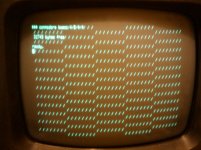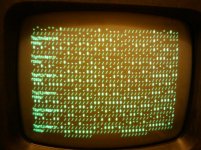rorypoole
Veteran Member
8032 now not working!!!
8032 now not working!!!
the 8032 was working fine for about 3h it did beep when I got about 3 carecters from the end but now its not working, cruped display, and wont run any commands, and I was having fun with test programs and saving them to tape.
the first pic is after I switched it off and on, and the second pic is after I pressed enter a few times, it will now not execute any commands, bad rom?
the 8032 is riddled with dry solder joints that spit the solder out when you try to resolder them, any one know what makes this happen?
bank switching the roms looks easy
8032 now not working!!!
the 8032 was working fine for about 3h it did beep when I got about 3 carecters from the end but now its not working, cruped display, and wont run any commands, and I was having fun with test programs and saving them to tape.
the first pic is after I switched it off and on, and the second pic is after I pressed enter a few times, it will now not execute any commands, bad rom?
the 8032 is riddled with dry solder joints that spit the solder out when you try to resolder them, any one know what makes this happen?
bank switching the roms looks easy
Attachments
Last edited:


